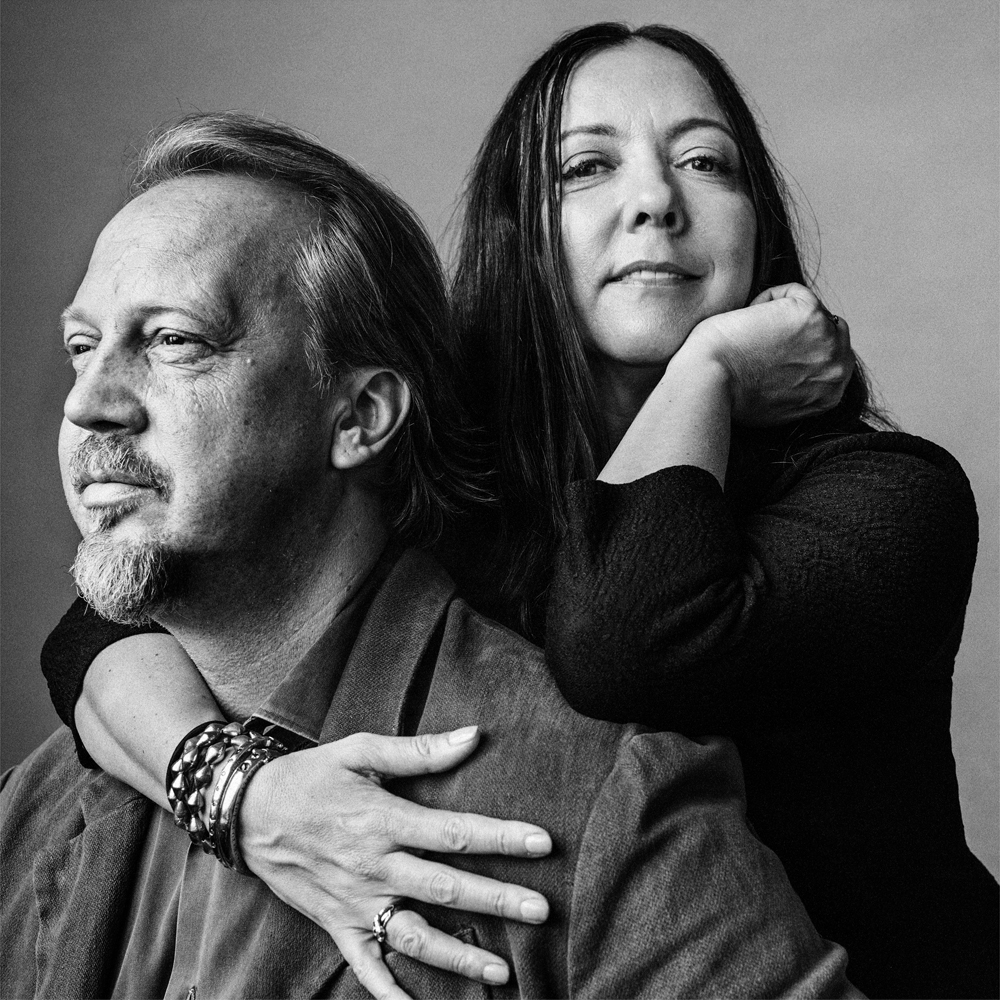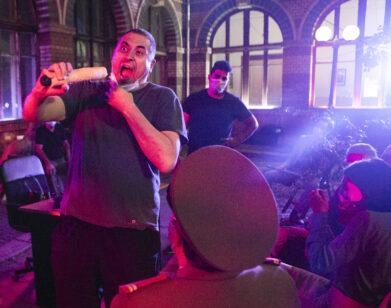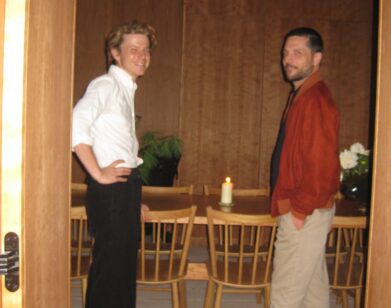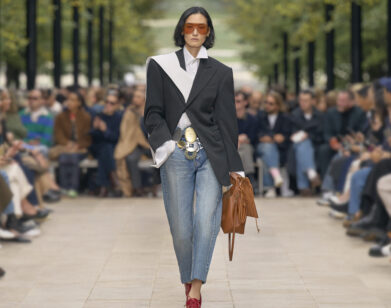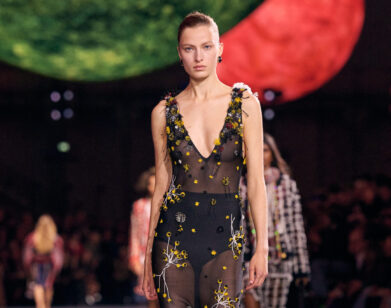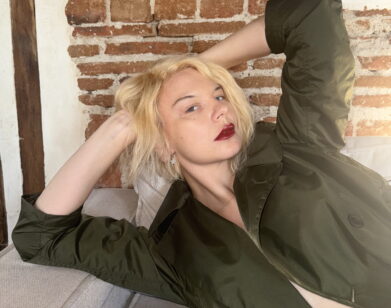Robin Standefer & Stephen Alesch
The philosophers tell us it doesn’t exist; environmentalists warn it may never come to pass—or at least not with us as witnesses—but the future, if and when it arrives, might look a lot like the spaces designed and built by the firm Roman and Williams. It wouldn’t be by accident.
The two partners, Robin Standefer and Stephen Alesch (who named the firm for their grandfathers), think a lot about the sustainability and lasting power of their creations, from the smallest scale objects all the way up to their monumental creations for the Standard and Ace hotels, as well as their coming design of Anthony Bourdain’s pioneering new food hall on a pier off Manhattan’s western edge. But their designs are anything but the stark, white cubes of some science-fiction future. Standefer, 52, and Alesch, 50, who were married in 2005 and spend much of their weekends getting dirty, gardening, making pottery, and surfing at their rustic Montauk home, are building something more organic, richer, warmer to the touch, more vibrant, and, as Alesch describes it, “gnarlier.”
The couple met in 1992 while working in film, when Standefer was a production designer and Alesch, a set designer, and they still describe their work with Hollywood vernacular, still seek to make theatrically pleasing vantages in their environments. In Los Angeles, one of their collaborators, for whom they designed Zoolander (2001), was Ben Stiller. And when they segued into residential design, Stiller and the couple’s other celebrity friends were among their first clients. In short order, that work led to commercial design—perhaps most memorably on New York’s Standard, High Line, floating above the Hudson River and topped by their swooping, elegant gem of a room, once called the Boom Boom Room and still the site of the most glamorous to-dos in town. Even on the top of the design world, as they are, Standefer and Alesch are looking ahead, to bigger, bolder projects.
Shortly after the opening of their newest, the Ace Hotel New Orleans, Standefer and Alesch dropped in to the Los Feliz home of their friend Kim Gordon to talk about their mutual punk rock roots, about working with a spouse, and about building utopias.
KIM GORDON: So here we are—it was just a ploy to get you over to my house to give me design tips. We actually met through your old friend Jamie Brisick.
STEPHEN ALESCH: Yeah, really old friend.
GORDON: You grew up in California, right?
ALESCH: Yeah. My bio is pretty short. “Born in Wisconsin,” that’s my whole bio. I moved to California in third grade, and Jamie Brisick was one of my first friends. We moved up to the hippie hills, in the Malibu Canyon kind of area.
GORDON: Does that play into your design aesthetic?
ALESCH: [laughs] Well, my family had a beautiful house in the hills. It was just gorgeous. But I was very sensitive to the fact that when you came down the hill, it was civilization—a freeway, malls, strip centers. It was just shit. Down the hill, in middle school and high school, it was a synthetic kind of hell with fluorescent lights. And, going back home, it was a warm environment and beautiful, nature. My mom was a great decorator, and our house was always really pretty, flowers everywhere. We weren’t wealthy, but my mom set a great scene. So I always had a chip on my shoulder about the ugliness down the hill.
GORDON: I grew up in L.A., on the Westside. And I definitely have, like, an existential idea about the finality of it, of it being so flat and narrow. What about you, Robin? How do you feel the environment that you grew up in shaped you? I know you went to Smith, which is a counterculture school.
ROBIN STANDEFER: Being in Massachusetts was strange, like being in a satellite from New York. I grew up in New York. And growing up there in the ’70s was a particular kind of intense, gritty, but also glittery world. And I think that kind of juxtaposition, like Stephen talks about going from the hill down into the ugliness, I lived uptown, but my uncle who I spent a lot of time with lived downtown in the Village…
GORDON: It must have been so beautiful in the Village then.
STANDEFER: Totally. Like, distinct and romantic in an intense moment of transition. And I was always into that transition. I think that has a lot to do with my aesthetic and what brought Stephen and me together. Smith was something else. But in a way, I didn’t appreciate it that much then. I just wanted to get back.
ALESCH: You were focused on boys.
STANDEFER: I was. [laughs]
GORDON: Well, Smith is an all-girls school.
STANDEFER: It was interesting to be in such a rural place. I definitely liked it, but it was a little isolated at that time. Now I think I appreciate it a lot more. Coming from the kind of intense artistic crush of New York at that moment, it was hard to be there. It had a pretty powerful impact on me. I just don’t think I recognized it for 20 years.
GORDON: You both worked in film production. You were a production designer?
STANDEFER: That’s how we met.
GORDON: What did you do, Stephen?
ALESCH: I was a set designer, which is sort of a production designer’s tool. [all laugh] And an art director. I guess I was a bit more of a set designer because I draw a lot. I’m not an administrator. I’m not good at, like, managing a crew of 150 painters and carpenters, which is what an art director really does. But, yeah, I was a set designer for Robin.
STANDEFER: I think that seeing him do drawings and just seeing those pictures come to life in his hands was so alluring and amazing. We started production-designing together. It was cool, too, being a woman at that moment. I was pretty young. I was only 26 when I started production designing.
GORDON: No way.
STANDEFER: And I actually lied about my age. I said I was, like, 28. And then when I turned 32, I was like, “I better stop doing this. This is going to time out on me.” I am not the type for building big things, and it was hard for a lot of male producers to get their head around that. So Stephen and I joined forces, and together, we started to make some really big environments, big movies.
ALESCH: And we ran some huge crews on the last couple of films we worked on. Big stages, big crews: a hundred carpenters, a hundred painters, a hundred set dressers, prop holders. It was like Wizard of Oz.
STANDEFER: It’s like an army.
GORDON: Wow. And in your design, you seem like you are very aware of people and objects in spaces, and how they move.
ALESCH: I think we always think of the camera—your eye, the first reveal. You know, you have to have that impact whether you walk into a house, you walk into a restaurant, you walk into a hotel; that first powerful impact establishing shot. That’s another term from film, establishing shot.
STANDEFER: I’m just thinking about the question and the word. We, all three of us, have talked about this a lot, the word design. When you work in art, fine art—I painted for a long time and was kind of a part of that world—and I guess design was always something that felt a little bit decorator-y to me.
GORDON: You might as well say “new wave.”
STANDEFER: [laughs] So working in film was always about experience. The narrative, the experience, which is such a part of the environment we create.
ALESCH: Design only comes into play in film as a problem, where something’s wrong.
GORDON: Because it’s too stylized?
ALESCH: Yeah. There’s a character flaw.
STANDEFER: If something felt contrived, a great director would use the word design. So that word never had a lot of resonance for me, for us. And all of a sudden, we found our way into doing this. It’s kind of awesome because we got tired of things being impermanent, even though they look good on celluloid and wanted people to experience them. But experiences are more important than design. Design just feels a little intense and narcissistic. There’s something beautiful when you pour your heart into objects and then people have them and use them. But sometimes design spaces can feel inanimate. We’re interested in things being animated. I really bristle at the word design. If I talk about interior design, I try to find the language to express it. It’s tricky because that’s the business we’re in. We do design. That’s what we are, but it’s not what we are.
GORDON: You feel like an invader.
STANDEFER: That’s it! We were in a meeting the other day, and I said to Stephen, “I feel like a weird interloper, just not part of this environment.” There’s kind of an anarchy in the way we approach it, which is not as “professional,” if you will, because we were never trained. We were outsiders.
GORDON: You didn’t get the ideology …
ALESCH: We do have a bit of an ideology beneath our surface, and that is to make things that don’t suck [all laugh], that aren’t boring. I was thinking about the era that we grew up in—it was a little punk rock. The “you suck” mantra; it’s slightly competitive. I remember yelling out, “You suck!” all the time as a kid. I would go see bands and yell out, “You suck!” It was a slogan. And now I’m 50 years old, but my driving force is this “you suck,” mentality, like, “Give me a chance, let me show you what I can do.”
STANDEFER: There’s a little bit of an underground competitive mantra to it. And that binds us. We’re a little high, back-to-back together, saying, “You suck!” Let’s see if we can try to make other shit.
GORDON: How does the Met feel about that? [Roman and Williams is working on the interiors of a gallery renovation at the Metropolitan Museum of Art.]
STANDEFER: The people we’re working with, I think they kind of dig it. They’re interested in a new point of view. One of them in particular has a powerful background and is interested in the aesthetic of status quos, but that’s an unbelievable situation, because they’re super well-educated and have a heavy-duty foundation. But they are ready to question authority. We’ve always found our way with people who wanted to have that dialogue. With people that don’t, it doesn’t go over so well.
GORDON: But your spaces really seem to take into account objects. Like, you have as much love for objects as spaces.
ALESCH: We’ve never really found a way to describe it other than the word love. We have a project, and we focus on it. And we start procuring objects for that. We kind of go into a love state.
STANDEFER: Yep.
ALESCH: You put yourself into the mind of the client or the user, and it’s like a Casanova kind of thing. You just fall in love with all the objects that are in that general direction. We fall in love with them and collect them and bring them into the room.
STANDEFER: We treat architecture that way also. Like, a door becomes part of that narrative, almost as an object. So, sure, we think about it holistically, but we build those spaces from a collection of parts. And then it’s, “Okay, is it haunting? Does it resonate?” We have a word we use called is-ness. Like, if it just is. Like, is there is-ness there? You come in and you don’t know where it came from; you can’t put your finger on it. And we don’t always hit it, but that’s the goal. We want that feeling, that temperature, that resonance where you just hear that noise from it.
GORDON: It’s almost like having a mood board.
STANDEFER: A living one.
ALESCH: You know, it’s funny; we never make mood boards.
GORDON: I love the idea of mood boards. I want to make a film using a mood board.
STANDEFER: We do collages, which is our version. Sometimes we’ll have, like, an orange peel on it. It’s about texture, layers; it starts to get 3-D. The idea is that you can walk into it, like it’s animated. But then there are so many people involved—builders and developers and people who spend money and engineers—you have to keep your center of construction.
ALESCH: It’s intense, but you’re having a magical, emotional relationship with the project and you’re trying to find this direction. And you establish it and get everything going—years of planning, another year for construction. Some of these projects are five years. It’s three to five years for a more substantial project. A restaurant would be a year or a year and a half. But it’s like you have to maintain this magical, emotional, loving relationship with something that takes that long to put together.
STANDEFER: And this sense of spontaneity, you do try to get it. Being on a film set, you can do that in the moment. The directors, the actors—they try to take the whole world out and just seize that moment. We try to keep that energy throughout the whole process. But when you’re in year three, and you’re, like, doing the Boom Boom Room or whatever, and there’s money issues, there’s permit issues, there’s structural issues, and you have to try to protect that part of your brain and your heart so you don’t kind of give up, so you can finish with all that same energy you started with. We don’t give up. That’s what I guess has defined Stephen and me, too. We just don’t want to give up that idiosyncratic kind of confused direction.
GORDON: There’s a real power in collaboration. I’ve found that in collaborating while making art, it takes you to a place that you wouldn’t necessarily have the confidence to go on your own.
STANDEFER: You’re braver, right?
GORDON: Sure, right. I’m curious what your working reality is compared to nonworking reality, in terms of your relationship? I was, you know, in a couple in a band, and there was this sense of wanting to create some distance on tour in a working situation.
STANDEFER: Oh, interesting.
ALESCH: Yep. We toughen up at work a little bit. We watch our step a little more—we don’t just baby talk to one other. [all laugh] On the weekends, we’re total giant babies. We cater to each other and are really not the tiniest bit hard on each other when we have a breakdown. But at work we have to be tough. We have to say to each other sometimes, “Toughen up.” We’re both demanding. We’re both bossy. We can be that way with each other or our staff. It’s not like classical music playing all day long. [Standefer laughs] It’s meetings and sketching. Robin’s really tough and demanding. If I slack off or get lazy, she picks up on it right away. And vice versa. If she’s moving too quickly on projects, I’m like, “Slow down!” Like you said, you need some distance onstage and on tour.
STANDEFER: Totally. I think you have to be able to connect with your own creativity, your own vision, and then make it strong together. The experience is very different in private or in public. But I guess making things is such a big part of our reality. And we’re a little tireless. You’ve seen us in Montauk—we’re planting, cooking. We just don’t lie around that much. We have that in common.
GORDON: This is a question that I don’t like to be asked, but I will ask it. Do you have a dream project? I get asked, What is the big thing I want to accomplish in my life? I actually don’t have anything.
STANDEFER: [laughs] That’s made it hard to answer.
ALESCH: I have one. It goes back to coming down that hill as a kid. My mom was a schoolteacher. She had a little nursery school and kindergarten in the old house I grew up in. So when I’d leave for school in the morning, there would be little school desks and a beautiful room, beautiful lights. Little kids would start to come to my house. And I would walk to school, to this fluorescent-lit box with a 1972 design …
GORDON: I went to a beautifully designed elementary school. And I feel like it had a huge impact.
ALESCH: Oh, beautiful. I would love to work on a high school. You see some really horrible high schools; they’re like prisons. And you just make a gorgeous space—not too expensive, gorgeous light, beautiful materials—and I tell you, those kids are going to come out less hardened. A little less indifferent. Maybe a small university …
GORDON: If you ever get the chance, check out my school, at UCLA [UCLA Lab School, formerly known as UES]. Each classroom had an outdoor patio, and it was all kind of sloped. There was this huge back area where we had an adobe house and a wagon train. There was a maze that we could run around in. And then, in the front, a huge glass area, and on the other side, a huge blacktop. It was crazy.
STANDEFER: Oh! So that’s what we want to make. [laughs] The idea of a school or a museum, this sense of community—even an airport—bringing some humanity to some of these kinds of spaces where people really need it.
ALESCH: Prison would be cool.
GORDON: No joke. That would be amazing.
STANDEFER: On a physical level and architectural level, it would be awesome. I think wanting to make things that people can live with but are lasting … I guess that sounds a little bit utopian, but we have some interest in that.
GORDON: You have to start somewhere.
STANDEFER: You do. So why not start with utopia?
ALESCH: We have a vision. Our vision of the future doesn’t look like a white iPhone or a perfect white pod, a white cube house. Our vision of the future is always more layered, gnarlier. I don’t know if you’d think of us as futurists, but I kind of think we are.
GORDON: The power is in the future.
STANDEFER: Because does the future even look like the future? A hundred years ago, everybody thought the future was some weird kind of Jetsons future with a space pod. And we question that. Maybe we want our future to be a little earthier. And I think it comes from our parents; they were hippies. I think we both come back around to that.
GORDON: Right. People are obsessed with cleanliness.
ALESCH: Yeah, they are. Untouched. In the future, I don’t think we’re going to have the option of everything being touched or untouched. There are going to be more people on earth, and I think you have to embrace the fact that you have objects that last longer, that they won’t have as many moving parts. We see the future as, like, a chunk of wood. It’s an amazing technological product. It’s very reliable. It doesn’t break. [all laugh]
STANDEFER: Talk about humble!
ALESCH: I don’t want to sound too high and mighty about green things, but there’s nothing stopping anybody right now from growing a tree and harvesting it in 75 years. It’s just planning and intelligence. When you think of the future, you always think of this whiteness and plastic. There’s absolutely no reason why the future can’t include absolutely sustainable farming. We can have a frickin’ tree farm on Mars. There’s no reason our future can’t have natural materials.
STANDEFER: Well, to that point, we don’t know whether the future lasts another hour or 300 years. I think that’s kind of important. I think about that a lot. I don’t know if there is going to be an 85 years from now. But looking at an object and believing it could last that long is a totally separate enterprise.
GORDON: Okay, what’s for dinner?
STANDEFER: Yeah, exactly. [laughs]
GORDON: You’re both such amazing cooks. I like hanging out with you guys.
ALESCH: Let’s go get some lunch.
KIM GORDON IS A MUSICIAN, VISUAL ARTISTS, AUTHOR, AND FOUNDING MEMBER OF SONIC YOUTH.

